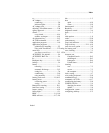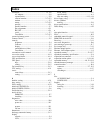
Glossary
hexadecimal - A numbering system that consists of 16 symbols, 0 to 9 and A to F; used by
programmers as a convenient method of expressing binary values.
input - Information that enters the computer.
input/output - An operation that transfers information from the central processing unit to
a device or from a device to the central processing unit. An example is storing and
retrieving information with a diskette.
integrated circuit - A microscopic grouping of electronic components and their
connections mounted on a small chip of material, usually silicon.
internal commands - The core program of the operating system (for example, MS-DOS)
that consists of commands necessary for day-to-day operations, such as copying files.
internal memory - A temporary storage area for information (programs and data) in
binary form.
KB - An abbreviation for 1,024 bytes; used to designate the memory capacity of a
computer or the storage capacity of a storage device.
keyboard - A device, similar to a typewriter keyboard, that allows you to communicate
with your computer.
kilobyte - 1,024 bytes, abbreviated KB.
LCD - See liquid crystal display.
liquid crystal display (LCD)- A display made of material, the reflectance or
transmittance of which changes when an electric field is applied.
Glossary 9


















